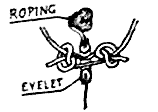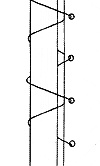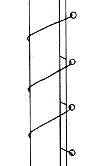Sails
Many books and recommendations for lacing sails
to spars refer to the use of a long continuous lacing, but there
are two disadvantages to this. Firstly it is awkward to reeve,
and secondly, if the lacing parts, then the whole length of
the sail is loose. Such breakage invariably happens in rough
conditions, and disturbs the set of the sail at a time when
efficiency is desired by dire necessity. If separate lashings
are used then both the above objections are removed. The breakage
of one lashing is not anything like a disaster, and repairs
may be effected at a more convenient moment than the throes
of a squall. A reef knot is commonly used for the separate lashings, but a better way is suggested. A reef knot can fly loose when
the weather is boisterous, and often has the ends flapping about.
If two simple thumb knots are used, around the standing part,
one on each side of the sail, they lock each other against the
eyelet, and the ends may be short enough not to offend. There
is nothing hanging below the spar, except one single turn of
line.
but a better way is suggested. A reef knot can fly loose when
the weather is boisterous, and often has the ends flapping about.
If two simple thumb knots are used, around the standing part,
one on each side of the sail, they lock each other against the
eyelet, and the ends may be short enough not to offend. There
is nothing hanging below the spar, except one single turn of
line.
There is a proper method of lacing the luff of
the mainsail to the mast. It is incorrect to wind the line continuously
round the mast and through the eyelets in one direction. The
direction of winding should change at each eyelet, so that the
line does not jam when lowering the sail, or when raising it
for that matter.
 Correct
Correct |

Incorrect |
When it comes to reefing for heavy weather, it
is usual for the mainsail to be reefed by rolling the sail round
the boom by one means or another. I suggest that the traditional
method of reefing by points is the better way. It can be done
reasonably quickly if it has been practised, and certainly results
in a better setting sail, without boom droop. If the reef points
are arranged so that the reef is deeper towards the leach, then
the boom is raised away from the heads of the crew. One of the
problems of point reefing is that it is possible to mix up the
reef points of the first reef with those of the second, and
tearing the sail. Using reef points of different material can
guard this against, and by placing them at, say 24” intervals
for the first reef, and 18” intervals for the second.
When taking hold of reef points for the purpose of taking in
sail, it is useful to give a tug on them, so as to be sure that
they are the same pair.
Reef points are seldom fitted to foresails these
days, but it is a very useful way of balancing a reefed mainsail.
A row of points, 24” up from the foot, with a large thimble
worked into the luff wire provides for a quick operation. A
large snap shackle at the tack enables a speedy reef to be put
in, and the jibsheet fastening previously mentioned is swiftly
moved to the new position. This method is by far to be preferred
to the other emergency jib reef, where the sail is lowered,
the halliard detached, a large knot tied in the head of the
sail, the halliard re-attached and the sail hoisted again.
The virtues of the jib roller furling gear have
been extolled by abler writers than me, and I have found that
the standard Wykeham Martin no.1 is adequate for my needs. It
is made in bronze and I bought mine from Mr Bosun’s Locker
in London. It uses a thrust bearing employing separate balls,
and these can be replaced during the winter refit for the cost
of a few pence. Modern racing dinghy jib furlers are made from
aluminium alloy, with plastic bearings, and are a lot more expensive
to buy, and cannot be serviced with ease.
In the days of square rigged sails it was possible
to extend the sail area by the use of the bonnet and drabbler.
A bonnet was a piece of extra sailcloth with eyelets along the
top and bottom, and was laced to the foot of a square sail in
very light winds. If the area still was not enough for a satisfactory
rate of progress, The drabbler was laced to the foot of the
bonnet. On the odd occasion when I have been sailing on a run
up the River Lune towards the pub known as Snatchems (otherwise
the Golden Ball) I have been known to rig my version of the
bonnet and drabbler, aka my water sail. This is a spare jib,
with the luff stretched out along the boom, the head next to
the gooseneck, tack to boom end, and the clew held out by the
boat hook.
Another ploy when reaching in very light winds
is to hank the spare jib to the windward shroud, hoisting it
by using one of the topping lifts as a halliard, and sheeting
it to the windward quarter. I only used this when out at sea
on a long reach in gentle winds.
I have always used a kicking strap on my boats.
It need not be an expensive stainless six-part purchase, but
a simple 2 or 4 part if rigged properly. The way that mine is
arranged is to have the lower fixed point on the centreboard
case, a little aft of the mast. If mounted on the mast it would
work well enough, but if rigged a few inches aft, then when
the boom swings wide, the whole set-up is tightened automatically.
After all, the kicking strap is most needed when running. Of
course pre-stretched terylene is used.
A burgee is best hoisted attached to a 2 or 3
foot piece of bamboo. Cane costs next to nothing, is easily
replaced, and suffers far less damage than expensive aluminium,
as snags when hoisting are very common. I have found that a
tubular windsock form of burgee is much steadier than the usual
triangular pattern.
Just as a matter of interest, it is quite in order
for a gaff rigged boat to wear her Red Ensign two-thirds up
the leach of the mainsail, instead of on a staff at the stern.
A simple eyelet on the leach makes this possible with a very
light line down to the boom end. This causes a little argument
now and again with some sea lawyers who do not know the proper
rules, and much amusement can be had.
Next Month: Spars


